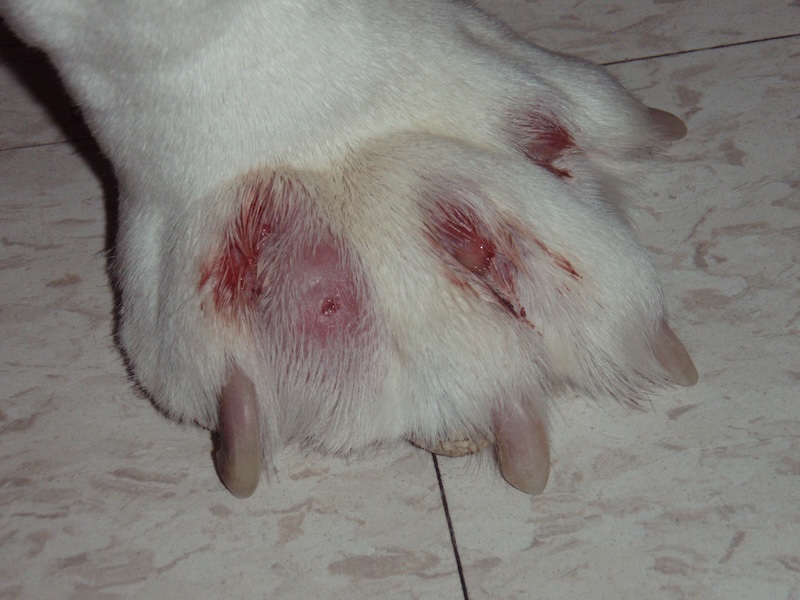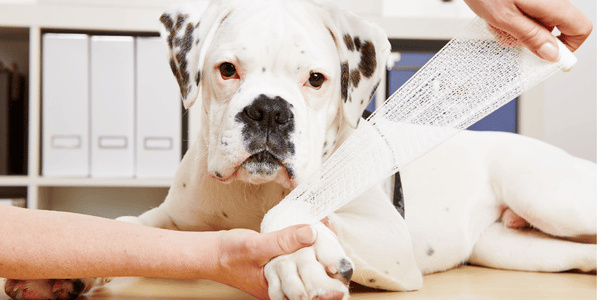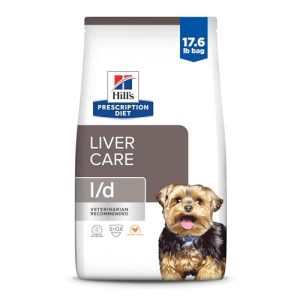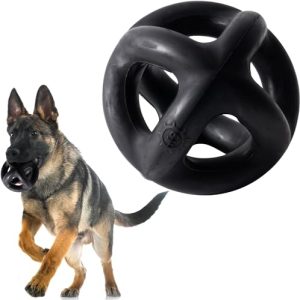Is your dog limping or constantly licking their paw? An infected paw can cause your furry friend a lot of pain and discomfort.
If you don’t act quickly, the infection could get worse and lead to serious problems. You want to help your dog feel better fast, but where do you start? You’ll discover simple, effective steps to treat your dog’s infected paw at home and know when it’s time to see the vet.
Keep reading to protect your dog’s health and get them back to happy, playful days.

Credit: www.reddit.com
Signs Of An Infected Paw
Recognizing the signs of an infected paw helps protect your dog’s health. Early detection stops infections from worsening. Watch closely for changes in your dog’s paw. Acting fast can prevent pain and serious issues.
Redness And Swelling
Infected paws often show redness around the affected area. The skin may look inflamed or irritated. Swelling causes the paw to appear larger than normal. These signs mean the body fights infection inside the paw.
Pus Or Discharge
Look for any pus or unusual discharge on the paw. This fluid can be yellow, green, or white. Pus indicates the presence of bacteria causing infection. Cleanliness is important to avoid spreading the infection.
Foul Odor
An infected paw may have a strong bad smell. The odor comes from bacteria and dead tissue. A foul smell signals that infection is active and needs care. Smelling your dog’s paw regularly helps spot problems early.
Limping Or Favoring The Paw
Your dog might limp or avoid putting weight on the paw. This behavior shows pain or discomfort from the infection. Notice if your dog licks or chews the paw often. These actions suggest irritation that requires attention.

Credit: www.merckvetmanual.com
Immediate Actions To Take
Acting fast helps reduce pain and stops infection from spreading. Immediate care soothes your dog and protects the paw. Follow clear steps to handle the situation safely.
Cleaning The Affected Area
Use lukewarm water to gently rinse the paw. Remove dirt and debris with a soft cloth. Avoid harsh soaps or chemicals that irritate the skin. Pat the paw dry with a clean towel. This step lowers bacteria and helps healing start.
Applying A Cold Compress
Wrap ice or a cold pack in a thin cloth. Place it on the swollen or red area for 10 minutes. Repeat every hour as needed. Cold reduces swelling and eases pain. Do not apply ice directly to the skin to avoid frostbite.
Restricting Movement
Limit your dog’s walking and running. Use a leash during bathroom breaks only. Keep your dog in a quiet, comfortable space. Rest prevents further injury and helps healing. Avoid letting your dog lick or chew the paw.
Home Remedies For Mild Infections
Dealing with a mild infection on your dog’s paw can be stressful, but you can often manage it at home before it worsens. Mild infections usually show redness, slight swelling, or minor discharge. Acting quickly with simple remedies can prevent the need for strong medications or vet visits.
Have you ever wondered if something as simple as saltwater could help soothe your dog’s paw? Let’s look at practical options you can try safely.
Saltwater Soaks
Saltwater is a natural disinfectant that helps remove dirt and bacteria from the infected area. Mix one teaspoon of salt in a cup of warm water and soak your dog’s paw for 5 to 10 minutes.
This method reduces swelling and cleans the wound gently. You can repeat this twice daily until you see improvement. Just make sure the water isn’t too hot—comfort matters as much as cleanliness.
Herbal Antiseptic Solutions
Certain herbs have antiseptic properties that can support healing. Tea tree oil diluted with a carrier oil, like coconut oil, works well when applied carefully to the paw.
Use a ratio of one drop of tea tree oil to a teaspoon of carrier oil to avoid irritation. Calendula ointment is another gentle option that soothes and fights bacteria. Do you have any herbal remedies you trust for your pet’s health?
Natural Anti-inflammatory Agents
Inflammation causes pain and slows healing, so reducing it is key. Aloe vera gel, when applied topically, cools the skin and reduces redness effectively.
Additionally, a small amount of honey can act as both an antibacterial and anti-inflammatory agent. Its sticky texture forms a protective barrier, helping the paw heal faster. Have you ever tried honey on minor cuts or scrapes before? It might surprise you how well it works on your dog’s paw too.
When To Seek Veterinary Help
Knowing when to seek veterinary help is vital for an infected paw. Some signs show the infection is serious and needs a professional’s care. Acting fast can prevent the infection from worsening or spreading.
Persistent Symptoms
Watch for symptoms that do not improve after a few days of home care. Redness, discharge, or licking that continues can signal a deeper problem. An infection that lingers may need prescription medication or special treatment.
Severe Swelling Or Pain
Swelling that grows quickly or causes your dog to limp needs urgent attention. Intense pain or sensitivity in the paw can mean the infection has spread. Veterinary care can provide pain relief and stop further damage.
Fever Or Lethargy
A fever or unusual tiredness shows the infection might be affecting your dog’s whole body. These symptoms suggest the infection is serious and requires professional treatment. Do not delay in getting veterinary help if your dog seems unwell overall.
Preventing Future Infections
Stopping infections before they start is key to keeping your dog’s paws healthy and happy. You can avoid many common issues by paying attention to simple daily habits. Small actions on your part make a big difference in preventing future infections.
Regular Paw Checks
Look at your dog’s paws often, especially after walks or playtime outside. Check between the toes and pads for cuts, swelling, redness, or anything unusual. Catching a problem early can save your dog discomfort and prevent a minor scratch from turning into a serious infection.
Ask yourself: Are you inspecting each paw thoroughly or just a quick glance? A detailed look once a day can reveal hidden debris like small stones or plant material that might irritate your dog’s skin.
Proper Grooming Techniques
Keeping your dog’s paws clean and trimmed helps reduce infection risks. Trim hair around the pads to prevent dirt buildup and matting, which trap moisture and bacteria. Use pet-safe shampoos and avoid harsh chemicals that can irritate sensitive paw skin.
When you groom, pay attention to the nails too. Overgrown nails can cause your dog to walk awkwardly, leading to cuts or sores that invite infection. Do you know how to safely trim your dog’s nails, or would a professional groomer be a better choice?
Safe And Clean Environment
Your dog’s environment impacts paw health more than you might think. Keep their living area clean and dry, especially if they spend time outdoors or on rough surfaces. Wet or dirty floors encourage bacteria and fungi to grow, increasing infection chances.
Consider the surfaces your dog walks on daily. Avoid sharp gravel, hot pavement, or chemical-treated lawns. Do you provide a soft and clean spot for your dog to rest their paws after outdoor adventures?
Choosing The Right Products
Choosing the right products to treat your dog’s infected paw can make all the difference in healing speed and comfort. It’s not just about picking any item off the shelf; you need products that clean, protect, and promote recovery without causing further irritation. Let’s look at some effective options that can help you care for your furry friend’s paws properly.
Antibacterial Washes
Antibacterial washes are essential for removing dirt and harmful bacteria from the infected area. Look for gentle formulas designed specifically for pets, as harsh chemicals can worsen the infection. I once used a chlorhexidine-based wash recommended by my vet, and it cleared up my dog’s paw infection quickly without any side effects.
Make sure to rinse thoroughly and dry the paw completely after washing. Keeping the area clean reduces the risk of the infection spreading or becoming resistant to treatment.
Protective Paw Balms
After cleaning, applying a protective paw balm helps soothe irritation and forms a barrier against further contamination. Choose balms with natural ingredients like shea butter or coconut oil, which moisturize and support healing. Avoid balms that contain artificial fragrances or colors, as these can irritate sensitive skin.
Applying a balm daily can also prevent your dog from licking or chewing the paw excessively, which often delays recovery. Have you noticed your dog obsessively licking their paws? A balm might be just what you need to break that cycle.
Veterinarian-recommended Solutions
Your vet’s advice is invaluable when selecting treatment products. They might suggest medicated sprays or ointments tailored to the specific type of infection your dog has. These solutions often contain antibiotics or antifungals that aren’t available over the counter.
Don’t hesitate to ask your vet for product recommendations or samples. Using the right vet-approved product can save time, reduce discomfort, and prevent complications down the road.
Managing Chronic Paw Issues
Managing chronic paw issues in dogs demands patience and a detailed approach. These problems often linger because the root cause isn’t addressed quickly. You might think treating symptoms is enough, but lasting relief comes from understanding what triggers the infection or irritation in the first place.
Identifying Underlying Causes
Look beyond the obvious signs like redness or swelling. Chronic paw issues can stem from allergies, fungal infections, or even environmental irritants like chemicals on the ground. Sometimes, a dog’s licking habit reveals anxiety or boredom rather than just discomfort.
Notice if the problem worsens after walks or during certain seasons. This observation can help pinpoint triggers such as pollen or salt used on sidewalks. Have you checked for foreign objects like small thorns or splinters hidden between the toes?
Long-term Care Strategies
Regular cleaning and inspection of your dog’s paws are crucial. Use a gentle antiseptic recommended by your vet to keep infections at bay. Avoid harsh soaps that can dry out the skin and make problems worse.
Consider protective booties during walks in rough or chemically treated areas. Also, trimming fur around the paws helps reduce debris buildup. Have you tried setting a routine to check paws after every outdoor activity?
Dietary Adjustments
Your dog’s diet affects skin and coat health, including the paws. Adding omega-3 fatty acids can reduce inflammation and improve healing. Supplements like fish oil or flaxseed oil often make a noticeable difference.
Cutting out common allergens such as wheat, soy, or corn might also help if your dog has food sensitivities. Have you discussed with your vet about trying an elimination diet to see if food plays a role in your dog’s paw problems?

Credit: lavengel.com
Frequently Asked Questions
How Do I Recognize An Infected Paw On My Dog?
Look for redness, swelling, discharge, or foul odor around the paw. Your dog may also lick or chew the area excessively. These signs often indicate infection and need prompt attention.
What Home Remedies Help Treat An Infected Dog Paw?
Clean the paw gently with warm water and mild soap. Apply a pet-safe antiseptic and keep the paw dry. Avoid harsh chemicals and consult your vet if symptoms persist.
When Should I See A Vet For My Dog’s Infected Paw?
Visit a vet if swelling worsens, discharge increases, or your dog shows pain. Persistent infection or fever requires professional treatment to prevent complications.
Can My Dog’s Infected Paw Heal Without Antibiotics?
Minor infections may heal with proper cleaning and care. However, moderate to severe infections often require antibiotics prescribed by a vet for full recovery.
Conclusion
Treating an infected paw on your dog takes care and patience. Clean the paw gently and keep it dry. Use vet-recommended medicine to help fight infection. Watch for signs like swelling or bad smell. Act quickly to avoid serious problems.
Regular checks help catch issues early. Your dog will feel better with proper care. Stay calm and follow simple steps. Healthy paws mean a happy dog.

Emily Barker is the founder of ChillDogLife.com, a space dedicated to helping pup parents discover the best dog products, lifestyle tips, and cozy ideas for happier homes.
A lifelong dog lover, Emily combines her passion for pets with a knack for research to share trusted recommendations on everything from toys and furniture to health and everyday care.
Her goal is simple: to make life easier, stylish, and more joyful for dogs and the people who love them.







